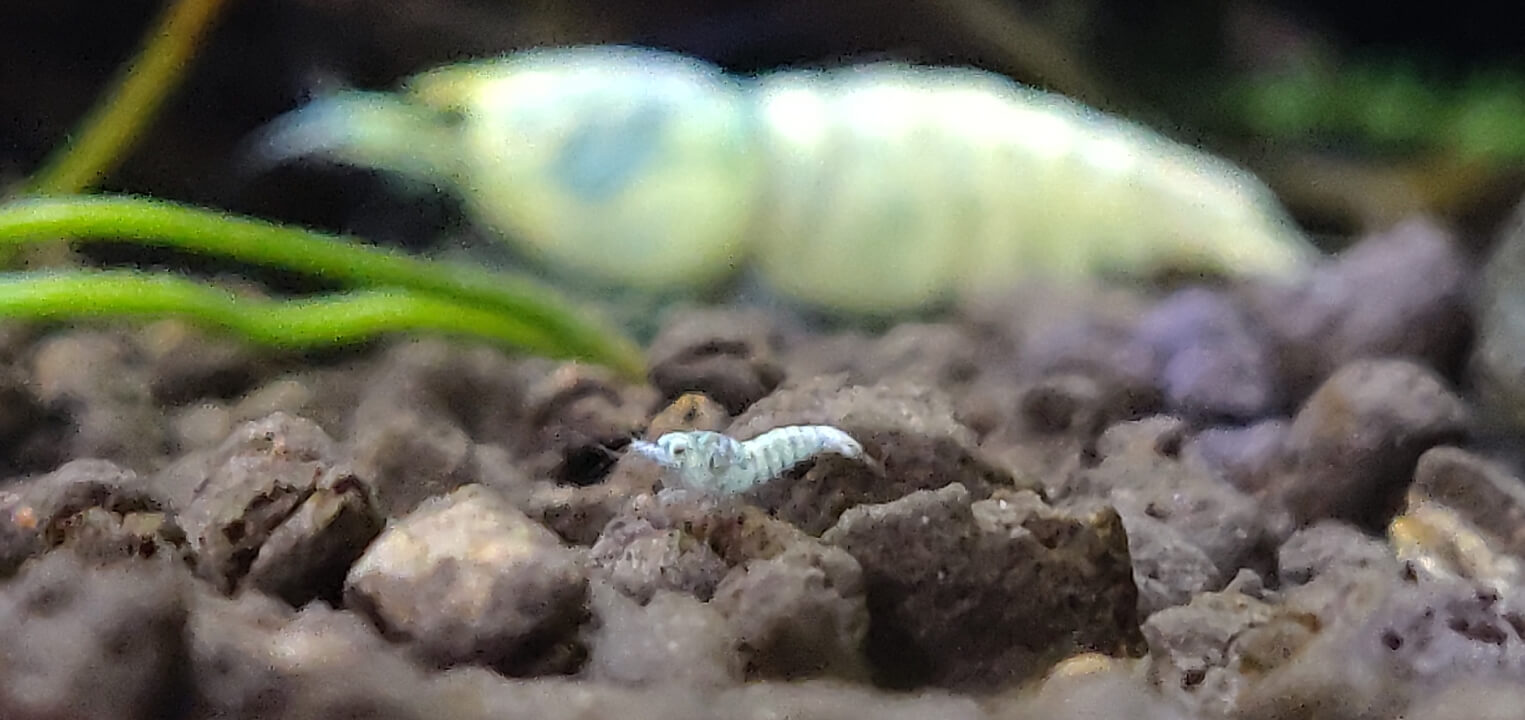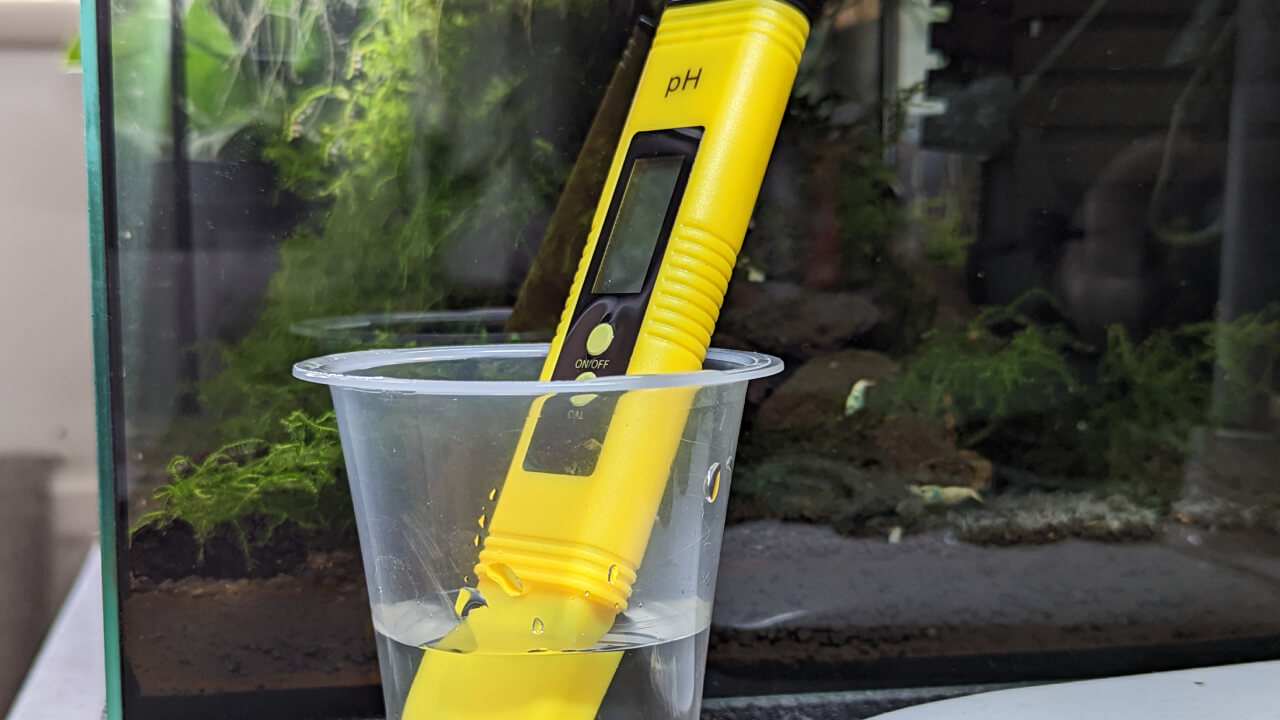The pH level of your water measures how acidic or alkali it is.
Different species of shrimp have different preferences for their water parameters.
- Neocaridinas prefer slightly alkali water, with a pH between 6.5 and 8.0
- Caridinas want acidic water, with a pH between 5.5 and 6.5
It’s important to make sure the parameters of your tank match what they need.
What is the pH?
The pH (Potential of Hydrogen) is an important water parameter for shrimp tanks. It measures how many free hydrogen ions are in a liquid.
A hydrogen ion is simply a molecule that has a positive charge, and is extremely reactive.
The pH scale goes from 0 to 14, with 0 being most acidic and 14 being most alkali. This reverse scale can be a little confusing at first. The lower the pH, the more acidic it is.
The scale is also logarithmic, meaning you need to multiply the number of hydrogen ions by 10 to raise the pH by 1.
This means that water with 6 pH is 10 times more acidic than 7 pH, and 100 times more acidic than 8 pH.
This is why it gets harder to keep pushing the pH lower once you’ve got to around 5.5 pH in your tank.
How does carbonate hardness affect the pH?
The carbonate hardness (KH) measures the buffering capacity of the water.
The buffering capacity of a liquid measures how resistant it will be to changes in pH.
A liquid with a tiny buffer capacity will experience pH swings when even small amounts of other acid/alkali elements are added.
Water with a high KH (buffering capacity) will be able to hold a steady pH level. Low KH water will have more extreme pH swings.
Buffering with KH works by calcium carbonate reacting with the hydrogen ions. The hydrogen gets consumed in this process, which then means the pH increases.
As you raise the KH, or buffering capacity, of the water, you also raise the pH level.
Acidic water for Bee shrimp
Caridina shrimp thrive in acidic tanks, they love the low pH.
In the wild, they live in rivers and streams filled with leaf litter.
These leaves, like Indian Almond leaves, can put tannins into the water, making it more acidic.
Keep a stable pH with a buffering substrate
Using an active substrate for your bee shrimp makes the water more acidic, and keeps it stable, even with a low KH.

Buffering substrates will normally wear out within 2 years. You’ll need to replace it to keep your water stable and buffered again.
Without anything to buffer the water, plants can cause a swing in your pH level and stress your shrimp.
Planted tanks can cause pH swings
When carbon dioxide from the air dissolves into the water, it creates carbonic acid, and lowers the pH.
In planted tanks, the plants will pull this carbon dioxide out of the water during the daytime. They convert it to oxygen by photosynthesis.
By using up the carbonic acid, the water gets slightly less acidic, and its pH rises.
At night, photosynthesis stops and the carbon dioxide builds up in the water again. This lowers the pH, as more carbonic acid is made.
Freshwater shrimp thrive in stable parameters and hate sudden changes. This is why it’s important to measure your pH, especially in tanks with low KH.
How to measure the pH
There are a few different ways to easily measure your water’s pH.
- A liquid test kit: dropping some test fluid into a vial and looking at the colour change
- A testing pen: holding a small device in the water until you get a stable reading
- Test paper strips: collecting a small sample of water, and dipping some paper in it to see the colour change
If you’re trying to check for changes in your pH over a few days, you should do the test at the time of day.
Planted tanks naturally fluctuate their pH level with the day and night cycle.
Using a liquid test kit
One of the most common ways of checking the pH is with a liquid test kit.
It can be a little hard to read the results accurately when you’re comparing the colours. You might prefer using an electronic test pen instead.
API’s freshwater test kit is a very popular choice, and these are the instructions for it:
- Add 5ml of water into the test vial
- Add 3 drops of the pH test solution
- Put the lid on the test tube, and invert the tube a few times to mix it
- Compare the liquid colour to the test chart
This kit only allows you to test between 6.0 and 7.6 pH.
They do have an alternative high range pH test kit which lets you test from 7.4 to 8.8 pH. If you want to try water outside these ranges, you’ll need another solution.
Using a testing pen
With a testing pen, it’s as simple as dipping the measuring end into your water.
You might find that it takes a few minutes to get a stable reading, though.
I collect a small amount of water into a cup, and leave the pH pen sitting in it for a few minutes.
Make sure your pen is calibrated correctly, or you might get some weird readings. If you’re not sure your pen is well calibrated, you can buy a test calibration kit online.
Using pH test paper strips
Test paper strips can be quite hard to read accurately.
Just like with the liquid test kits that need you to compare colours to a scale on some paper.
They’re still useful to get a rough idea of your pH level, but won’t give you a precise value.
Symptoms of the wrong pH
- Slow growing shrimp
- No breeding
- Babies not surviving
- Dying shrimp
Water with the incorrect pH level can cause a few health issues for shrimp. The effects range from stunted growth and slight stress all the way up to death.
If your shrimp are stressed or just generally not happy, you won’t get much breeding. They’ll be more focused on just surviving.
Any baby shrimp that do get born may struggle to grow in the poor water conditions.
How to lower pH
You should only mess with the water parameters in your tank if you’re seeing problems.
Don’t worry if your pH is just slightly higher than recommended, your shrimp would prefer the stability.
- Add tannins to the water
- Perform water changes with better parameters
- Use Seachem Acid Buffer
Adding tannins into your tank will make it what’s known as a blackwater tank. This can lower your pH, and help prevent infections at the same time.
Doing consistent water changes of up to 20% each time will gradually lower your pH. You can remineralize your own water to get the perfect parameters you’re looking for.
How to increase pH
If you’re seeing signs that your pH might be a little low, you can try to raise it a little.
Don’t increase it just because you’re slightly under the recommended level.
Only make changes if you think your shrimp are struggling.
- Add crushed coral, this will also increase the KH and GH
- Do water changes with higher pH water
Conclusion
Giving your shrimp a stable pH level will help them grow and stay healthy.
Buffering substrates are incredibly useful for Caridina shrimp tanks, as they lower the pH and buffer out any pH swings.
Mixing your own water for water changes is an easy way to keep your tank steady and happy.

